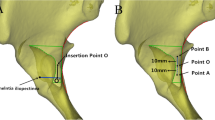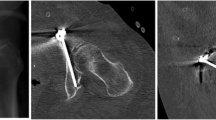Abstract
Introduction
Morphometric variations of the anterior column of the acetabulum have been described in the literature for its complex structure, which can influence the safe containment of intramedullary screw for fixation of its fractures. The purpose of this CT-based study is to present a preliminary report on the morphometric variations and safety of intramedullary screw fixation of the anterior column of the acetabulum in the Indian population.
Methods
CT-based data from 102 uninjured pelves were retrospectively analyzed in iPlanⓇ BrainLab AG, Feldkirchen, Germany. Narrowest zones around acetabulum and superior pubic ramus were measured. We calculated the axis of the anterior column of the acetabulum by joining the centres of these narrowest zones. Standard screws trajectories were directed along this axis. Screw length up to the first cortical perforation, the distance of the exit point from the pubic symphysis, and the length of the anterior column up to the pubic tubercle were measured.
Results
The osseous corridor of the anterior column of acetabulum had variable cross-section along its length with two constriction zones, first in the acetabular region and second in the superior pubic ramus. Only 54% of our cases allowed safe applicability of 6.5-mm-diameter screw trajectories with safety margin of 2 mm on either side of the screw. Significant morphometric and screw applicability–related differences were observed among male and female cases with males having a wider osseous corridor in general. Elimination of safety margin results in a significant increase in the screw applicability.
Conclusion
The osseous corridor of the anterior column varies in its dimensions from individual to individual. Standard screws of 6.5-mm and 7.3-mm diameters may not be safe for intramedullary screw fixation in every patient and carry a risk of cortical violation when a 2 mm of width around the screw is considered as a safety margin. However, with a precise screw placement within the extents of the cortices of the anterior column, 6.5-mm screws can be applied in most of the female cases and 7.3-mm screws can be applied in most of the male cases for anterior column fixation.




Similar content being viewed by others
References
Dunet B, Tournier C, Billaud A, Lavoinne N, Fabre T, Durandeau A (2013) Acetabular fracture: long-term follow-up and factors associated with secondary implantation of total hip arthroplasty. Orthop Traumatol Surg Res 99(3):281–290. https://doi.org/10.1016/j.otsr.2012.12.018
Bozzio AE, Wydra FB, Mitchell JJ, Ackerson RM, Mauffrey C (2014) Percutaneous fixation of anterior and posterior column acetabular fractures. Orthopedics 37(10):675–678. https://doi.org/10.3928/01477447-20140924-04
Feng X, Fang J, Lin C et al (2015) Axial perspective to find the largest intraosseous space available for percutaneous screw fixation of fractures of the acetabular anterior column. Int J Comput Assist Radiol Surg 10(8):1347–1353. https://doi.org/10.1007/s11548-015-1149-6
Wong JM, Bewsher S, Yew J, Bucknill A, Steiger RD (2015) Fluoroscopically assisted computer navigation enables accurate percutaneous screw placement for pelvic and acetabular fracture fixation. Injury 46(6):1064–1068. https://doi.org/10.1016/j.injury.2015.01.038
Mauffrey C, Hao J, Cuellar DO et al (2014) The epidemiology and injury patterns of acetabular fractures: are the USA and China comparable? Clin Orthop Relat Res 472(11):3332–3337. https://doi.org/10.1007/s11999-014-3462-8
Gras F, Marintschev I, Schwarz CE, Hofmann GO, Pohlemann T, Culemann U (2012) Screw- versus plate-fixation strength of acetabular anterior column fractures. J Trauma Acute Care Surg 72(6):1664–1670. https://doi.org/10.1097/TA.0b013e3182463b45
Caviglia H, Mejail A, Landro ME, Vatani N (2018) Percutaneous fixation of acetabular fractures. EFORT Open Rev 3(5):326–334. https://doi.org/10.1302/2058-5241.3.170054
Sen RK, Tripathy SK, Aggarwal S, Goyal T, Meena DS, Mahapatra S (2012) A safe technique of anterior column lag screw fixation in acetabular fractures. Int Orthop 36(11):2333–2340. https://doi.org/10.1007/s00264-012-1661-z
Routt ML, Simonian PT, Grujic L (2015) Preliminary report: the retrograde medullary superior pubic ramus screw for the treatment of anterior pelvic ring disruptions: a new technique. J Orthop Trauma 9(1):35–44. https://doi.org/10.1097/00005131-199502000-00006
Attias N, Lindsey RW, Starr AJ, Borer D, Bridges K, Hipp JA (2005) The use of a virtual three-dimensional model to evaluate the intraosseous space available for percutaneous screw fixation of acetabular fractures. J Bone Joint Surg (Br) 87(11):1520–1523. https://doi.org/10.1302/0301-620x.87b11.16614
Shahulhameed A, Roberts CS, Pomeroy CL, Acland RD, Giannoudis PV (2010) Mapping the columns of the acetabulum—implications for percutaneous fixation. Injury 41(4):339–342. https://doi.org/10.1016/j.injury.2009.08.004
Chen KN, Wang G, Cao LG, Zhang MC (2009) Differences of percutaneous retrograde screw fixation of anterior column acetabular fractures between male and female: a study of 164 virtual three-dimensional models. Injury 40(10):1067–1072. https://doi.org/10.1016/j.injury.2009.01.014
Ochs BG, Stuby FM, Ateschrang A, Stoeckle U, Gonser CE (2014) Retrograde lag screw placement in anterior acetabular column with regard to the anterior pelvic plane and midsagittal plane—virtual mapping of 260 three-dimensional hemipelvises for quantitative anatomic analysis. Injury 45(10):1590–1598. https://doi.org/10.1016/j.injury.2014.06.026
Iqbal F, Younus S, Asmatullah ZOB, Khan N (2017) Surgical site infection following fixation of acetabular fractures. Hip Pelvis 29(3):176–181. https://doi.org/10.5371/hp.2017.29.3.176
Sierra RJ, Mabry TM, Sems SA, Berry DJ (2013) Acetabular fractures. Bone Joint J 95-B(Supple A):11–16. https://doi.org/10.1302/0301-620x.95b11.32897
Peng Y, Zhang L, Min W, Tang P (2016) Comparison of anterograde versus retrograde percutaneous screw fixation of anterior column acetabular fractures. Int J Comput Assist Radiol Surg 11:635–639
Betti L (2017) Human variation in pelvic shape and the effects of climate and past population history. Anat Rec 300:687–697. https://doi.org/10.1002/ar.23542
Puchwein P, Enninghorst N, Sisak K, Ortner T, Schildhauer TA, Balogh ZJ, Pichler W (2012) Percutaneous fixation of acetabular fractures: computer-assisted determination of safe zones, angles and lengths for screw insertion. Arch Orthop Trauma Surg 132(6):805–811
Author information
Authors and Affiliations
Corresponding author
Ethics declarations
Conflict of Interest
The authors declare that they have no conflict of interest.
Additional information
Publisher’s note
Springer Nature remains neutral with regard to jurisdictional claims in published maps and institutional affiliations.
Rights and permissions
About this article
Cite this article
Trikha, V., Kumar, A., Mittal, S. et al. Morphometric analysis of the anterior column of the acetabulum and safety of intramedullary screw fixation for its fractures in Indian population: a preliminary report. International Orthopaedics (SICOT) 44, 655–664 (2020). https://doi.org/10.1007/s00264-019-04428-5
Received:
Accepted:
Published:
Issue Date:
DOI: https://doi.org/10.1007/s00264-019-04428-5




